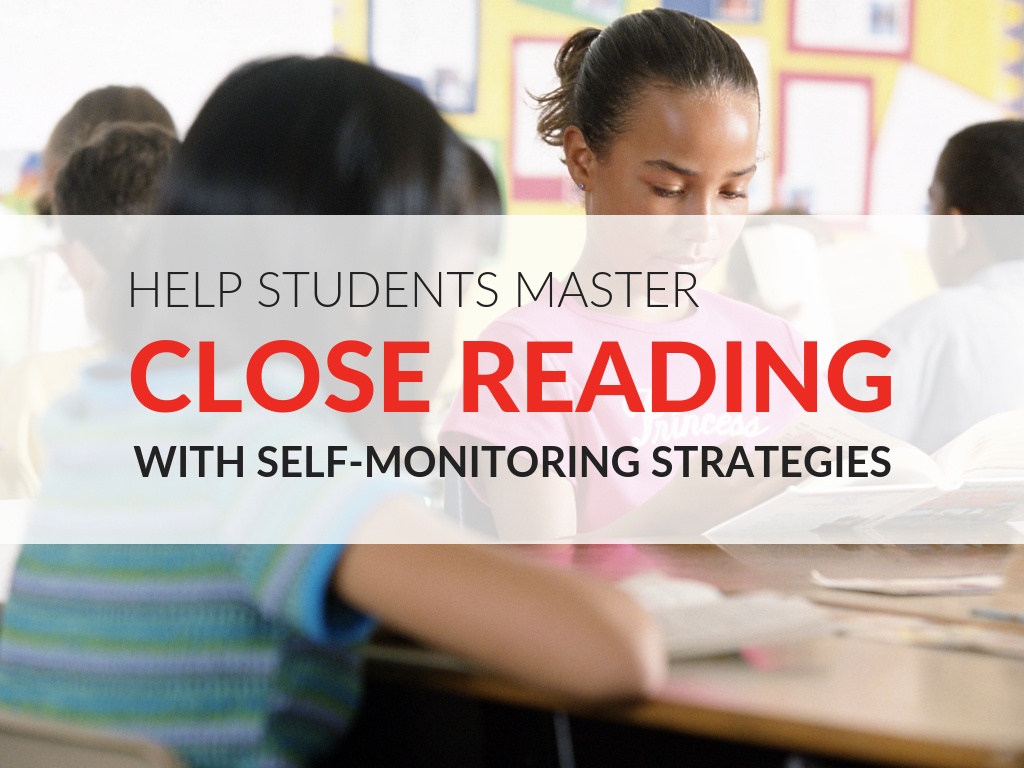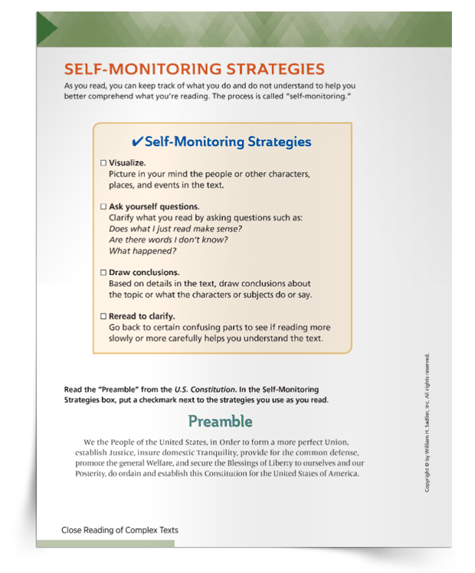March 21, 2019 ELA PD - Literacy, ELA K-5, ELA 6-8, ELA Focus - Close Reading, ELA Resources - Tip Sheets, Core Literacy
How Self-monitoring Strategies Support Students When Reading Closely
By: Erin Lynch
That sense of independence and belief in one's ability to comprehend a text independently often leads to students challenging themselves and taking more risks. By providing students with self-monitoring strategies, teachers help them reach a higher level of independence and a better understanding of how to analyze a text because they will not be so dependent on teacher support while reading a text.
Download the Self-Monitoring Strategies Checklist for students now!

Benefits of Self-Monitoring Reading Strategies
Self-monitoring strategies help students independently keep track of what they do and do not understand while reading a complex text. Other benefits of self-monitoring reading strategies include:
-
Give students greater independence
-
Foster a deeper understanding of a text
-
Enable students to learn more effectively
-
Encourage risk-taking
-
Promote students to take more responsibility for their learning
-
Empower students
Before you scroll any further...download the Self-Monitoring Strategies Checklist now and model these strategies for your students.
Self-Monitoring Reading Strategies to Help Students Better Understand a Text
When reading closely, students can use self-monitoring strategies to ensure they check for basic understanding and think more critically. The process of "self-monitoring" includes:
- Visualize
- Ask yourself questions
- Draw conclusions
- Reread to clarify
Below I've briefly outlined the process of self-monitoring. First, I will state the self-monitoring strategy and then give a brief explanation. Next, I will provide you with questions to share with your students to help them while using that strategy. Finally, I will give you one of the titles of a Patricia Polacco book I use to reinforce that particular strategy.
Strategy 1: Create a Visual
Students use their five senses to visualize what is going on in the text. By visualizing what is happening in the text, students are more likely to notice and remember details.
Questions for Students
When picturing in their mind the people or other characters, places, and events in the text, students can ask themselves the following questions:
-
Why is this visual important to the story?
-
How does this visual help you to better understand the story?
Book to Reinforce the Strategy
For this strategy, I like to use Picnic at Mudsock Meadow by Patricia Polacco. A great way to practice creating a visual is by reading a picture book to your students without showing them the pictures. After reading, have students create a visual of the most important part of the text. Then, show the students the book's illustration for that part and do a compare and contrast discussion.
Strategy 2: Draw Conclusions
Students use their background knowledge (b.k.) and clues from the text (t.c.) to make an inference (something that you know that the author does not come right out and tell you). Encouraging students to think about “why” a character did or said something, and “why” an author may have written the text, creates an environment where students are naturally making inferences.
Questions for Students
Students can think about questions like these while making an inference:
-
What new information were you able to figure out?
-
Why do you think the character did _____________?
-
Why do you think the character said _____________?
-
Why do you think the author wrote this text?
Book to Reinforce the Strategy
For this strategy, I like to use Chicken Sunday by Patricia Polacco. This book encourages students to make thoughtful inferences about the characters' actions.
Strategy 3: Ask Yourself Questions
Students need to remember that good readers are ALWAYS thinking and wondering. By actively reading, students will develop a better understanding of the text. Students should be aware of the difference between a thin and thick question.
Questions for Students
Thin questions are the ones where the answers are right in the text (you can actually point to the answer in the text).
-
Who is the main character?
Thick questions are those where the answers are supported by the text.
-
What is a possible lesson that can be learned from the story?
Encourage students to use questions like these while actively reading a text:
-
Who? What? Where? When? Why? How?
Book to Reinforce the Strategy
For this strategy, I like to use My Rotten Red Headed Older Brother by Patricia Polacco. This book is good for understanding the difference between thin and thick questions. For example, a thin question would be, “How does Richie help his sister?” A thick question would be, “What lesson does this book teach?”
Strategy 4: Re-Read to Clarify
Students need to go back to the text and re-read parts that are still confusing and/or to clarify misinterpretations. Re-reading will lead to a better understanding of a text and analysis at a deeper level.
Questions for Students
Here are some questions for students to think about while re-reading.
-
What new information did I learn?
-
What do I understand better?
-
How has my thinking changed?
Book to Reinforce the Strategy
For this strategy, I like to have my students reread any of the Polacco books mentioned above. I then have them answer one of these three re-reading questions.
-
What new information did I learn?
-
What do I understand better?
-
How has my thinking changed?
In Summary
Self-monitoring strategies have many benefits, such as giving students greater independence and fostering a deeper understanding of a text. These strategies enable students to learn more effectively and encourage risk-taking. Self-monitoring strategies encourage students to take more responsibility for their own learning and, most importantly, will empower students.




